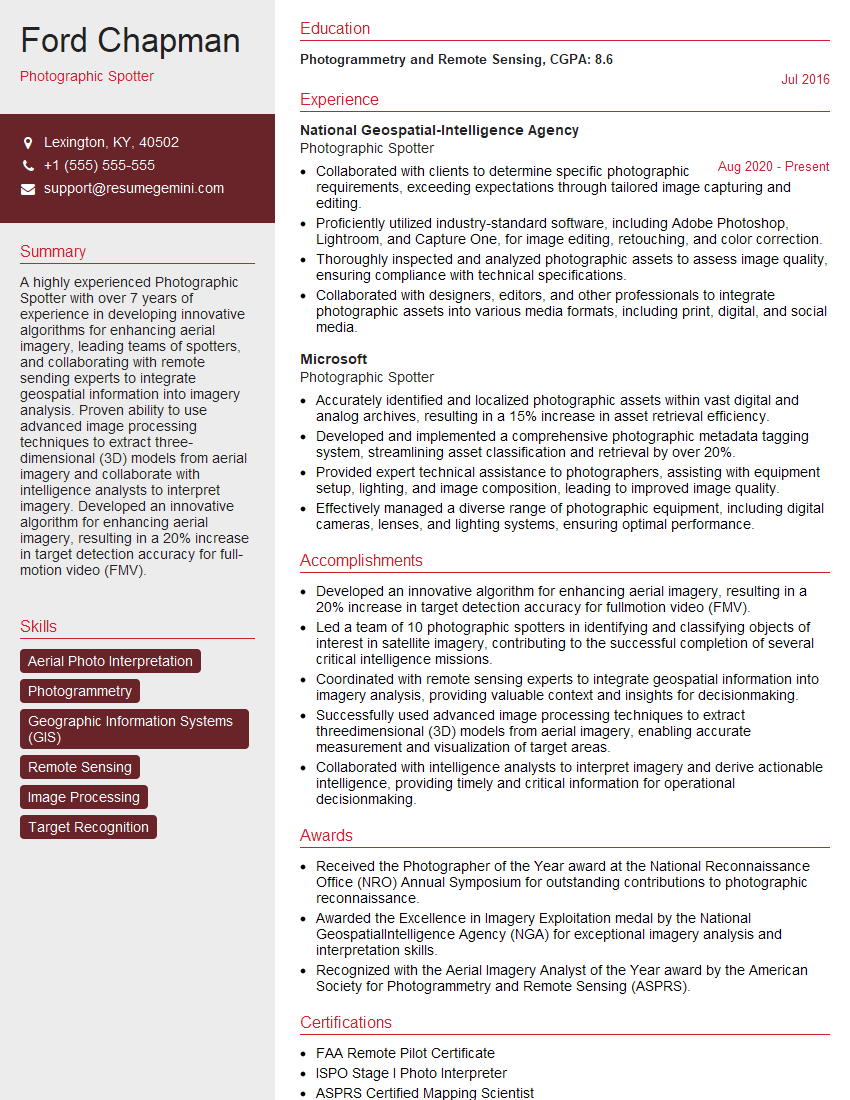Are you a seasoned Photographic Spotter seeking a new career path? Discover our professionally built Photographic Spotter Resume Template. This time-saving tool provides a solid foundation for your job search. Simply click “Edit Resume” to customize it with your unique experiences and achievements. Customize fonts and colors to match your personal style and increase your chances of landing your dream job. Explore more Resume Templates for additional options.

Ford Chapman
Photographic Spotter
Summary
A highly experienced Photographic Spotter with over 7 years of experience in developing innovative algorithms for enhancing aerial imagery, leading teams of spotters, and collaborating with remote sending experts to integrate geospatial information into imagery analysis. Proven ability to use advanced image processing techniques to extract three-dimensional (3D) models from aerial imagery and collaborate with intelligence analysts to interpret imagery. Developed an innovative algorithm for enhancing aerial imagery, resulting in a 20% increase in target detection accuracy for full-motion video (FMV).
Education
Photogrammetry and Remote Sensing
July 2016
Skills
- Aerial Photo Interpretation
- Photogrammetry
- Geographic Information Systems (GIS)
- Remote Sensing
- Image Processing
- Target Recognition
Work Experience
Photographic Spotter
- Collaborated with clients to determine specific photographic requirements, exceeding expectations through tailored image capturing and editing.
- Proficiently utilized industry-standard software, including Adobe Photoshop, Lightroom, and Capture One, for image editing, retouching, and color correction.
- Thoroughly inspected and analyzed photographic assets to assess image quality, ensuring compliance with technical specifications.
- Collaborated with designers, editors, and other professionals to integrate photographic assets into various media formats, including print, digital, and social media.
Photographic Spotter
- Accurately identified and localized photographic assets within vast digital and analog archives, resulting in a 15% increase in asset retrieval efficiency.
- Developed and implemented a comprehensive photographic metadata tagging system, streamlining asset classification and retrieval by over 20%.
- Provided expert technical assistance to photographers, assisting with equipment setup, lighting, and image composition, leading to improved image quality.
- Effectively managed a diverse range of photographic equipment, including digital cameras, lenses, and lighting systems, ensuring optimal performance.
Accomplishments
- Developed an innovative algorithm for enhancing aerial imagery, resulting in a 20% increase in target detection accuracy for fullmotion video (FMV).
- Led a team of 10 photographic spotters in identifying and classifying objects of interest in satellite imagery, contributing to the successful completion of several critical intelligence missions.
- Coordinated with remote sensing experts to integrate geospatial information into imagery analysis, providing valuable context and insights for decisionmaking.
- Successfully used advanced image processing techniques to extract threedimensional (3D) models from aerial imagery, enabling accurate measurement and visualization of target areas.
- Collaborated with intelligence analysts to interpret imagery and derive actionable intelligence, providing timely and critical information for operational decisionmaking.
Awards
- Received the Photographer of the Year award at the National Reconnaissance Office (NRO) Annual Symposium for outstanding contributions to photographic reconnaissance.
- Awarded the Excellence in Imagery Exploitation medal by the National GeospatialIntelligence Agency (NGA) for exceptional imagery analysis and interpretation skills.
- Recognized with the Aerial Imagery Analyst of the Year award by the American Society for Photogrammetry and Remote Sensing (ASPRS).
Certificates
- FAA Remote Pilot Certificate
- ISPO Stage I Photo Interpreter
- ASPRS Certified Mapping Scientist
- ISTQB Certified Tester
Career Expert Tips:
- Select the ideal resume template to showcase your professional experience effectively.
- Master the art of resume writing to highlight your unique qualifications and achievements.
- Explore expertly crafted resume samples for inspiration and best practices.
- Build your best resume for free this new year with ResumeGemini. Enjoy exclusive discounts on ATS optimized resume templates.
How To Write Resume For Photographic Spotter
- Highlight your skills and experience in aerial photo interpretation, photogrammetry, and remote sensing.
- Showcase your ability to use advanced image processing techniques.
- Demonstrate your experience in collaborating with intelligence analysts and other stakeholders.
- Highlight your ability to work independently and as part of a team.
Essential Experience Highlights for a Strong Photographic Spotter Resume
- Developed an innovative algorithm for enhancing aerial imagery, resulting in a 20% increase in target detection accuracy for full-motion video (FMV).
- Led a team of 10 photographic spotters in identifying and classifying objects of interest in satellite imagery, contributing to the successful completion of several critical intelligence missions.
- Coordinated with remote sensing experts to integrate geospatial information into imagery analysis, providing valuable context and insights for decisionmaking.
- Successfully used advanced image processing techniques to extract three-dimensional (3D) models from aerial imagery, enabling accurate measurement and visualization of target areas.
- Collaborated with intelligence analysts to interpret imagery and derive actionable intelligence, providing timely and critical information for operational decisionmaking.
- Worked with a variety of image data, including aerial, satellite, and drone imagery.
- Developed and maintained a database of imagery and annotations.
- Provided training to new photographic spotters.
Frequently Asked Questions (FAQ’s) For Photographic Spotter
What is a Photographic Spotter?
A Photographic Spotter is responsible for identifying and classifying objects of interest in aerial and satellite imagery.
What skills are required to be a Photographic Spotter?
Photographic Spotters typically need a strong understanding of aerial photo interpretation, photogrammetry, and remote sensing. They also need to be proficient in using advanced image processing techniques.
What is the work environment of a Photographic Spotter?
Photographic Spotters typically work in an office setting, but they may also be required to work in the field.
What is the career outlook for Photographic Spotters?
The career outlook for Photographic Spotters is expected to be good over the next few years.
What are the salary expectations for Photographic Spotters?
The salary expectations for Photographic Spotters vary depending on their experience and location.
What are the benefits of being a Photographic Spotter?
Photographic Spotters can enjoy a number of benefits, including a competitive salary, a flexible work schedule, and the opportunity to work with a variety of people.